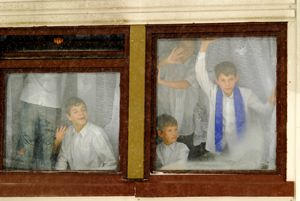Traditional values
More and more Ukrainian families want to adopt children
There is nothing better for a child than a family, even if this family is incomplete, with an incompetent mother or father, or if it is a foster family. At least that is what psychologists say. Ukraine has exhibited shameful statistics in this regard for years: the official number of orphaned children and children whose parents have been deprived of parental rights is somewhere around 102,000. The number of these children is not decreasing, even though 3,800 children were adopted last year, by Ukrainians and foreigners. Add to this a considerable number of children taken in by foster families and family-style refuges, or placed under tutelage. Yet there are many more children who need special care in Ukraine.
The beginning of a new school year in Ukraine activated the Lesson Campaign, when policemen, juvenile delinquency inspectors, doctors, journalists, etc., are searching for children who loiter on the streets, play truant, or have dropped out of school because they have no place to live in. For example, according to the State Department for Adoption and Protection of Children’s Rights, the preventive spot control two years ago (in the first quarter of the year) resulted in saving almost 7,000 children, the latest one showed 5,300. It makes a clear, albeit small, difference.
Two years ago, to focus attention on disadvantaged children, Viktor Yushchenko introduced Adoption Day to be marked each year on September 30. 2008 was proclaimed National Adoption Year, and it produced results. It is unclear if the current government will follow this tradition. Incidentally, Prime Minister Mykola Azarov recently spoke out in favor of a greater role of boarding schools in Ukraine. Den wrote about this on July 15, 2010. As of yet, the government has not said anything more about this issue.
Yet Ukraine has people ready to adopt children. Moreover, there is a factor stimulating such a response: every fifth or sixth Ukrainian family cannot have children. According to the State Department for Adoption and Protection of Children’s Rights, there are 1,802 officially registered families of this kind. As for the children who can be adopted, we have almost 30,000 of them. 1,636 Ukrainian children were adopted in the first half of 2010 (a third of them by foreigners). For comparison, 3,800 children were adopted in 2009 (a little more than 1,400 by foreigners). In 2005 the picture was different: out of all 3,529 foster children, 2,110 were adopted by foreigners. So Ukrainians have been adopting more children than foreigners have in the past three years.
The most widespread way of caring for children in Ukraine remains guardianship. According to the Ministry of Ukraine for Family, Youth and Sport, the total number of guardians in this country is 51,362 (as of the mid-2010). They are bringing up over 57,000 children. Experience shows that in 94.7 percent of cases the child’s relatives become guardians. Mainly grandparents hold themselves responsible for the children’s fates — in 59 percent of cases. Aunts and uncles adopt nephews and nieces in 21 percent of cases, adult sisters and brothers in 7.3 percent of cases, while other relatives make up 7.2 percent of cases. According to official information, only 5.2 percent of guardians are not relatives of the children in their care. These people are, as a rule, good acquaintances of the child’s parents, who knew the child and the family in which they lived (godparents, parents’ friends, etc.).
“Guardianship and care remain the most common form of adopting orphaned children and children deprived of parental care, and I am calling on Ukrainians to take in more children who need a family environment. It has always been a Ukrainian tradition that relatives, godparents, and neighbors care for children who, for some reason, are without parents,” Ravil Safiullin, Minister of Ukraine for Family, Youth and Sport, said, commenting on the socio-demographic characteristics of guardian families.
Having analyzed the information on Ukrainian guardians, one can conclude that over-40s are most likely to show a desire to take care of somebody. According to the abovementioned department, 48 percent of the guardians are aged 40 to 60 and 30 percent are over 60. Only 17 percent of guardians are aged 25 to 40, and 3 percent are below the age of 25. Half of the guardians and custodians have complete families, the others are usually single men or women. Women account for 84 percent of guardians, men — for 17 percent. Most of the guardian families (64 percent) reside in cities.
“56,844 children being brought up under guardianship or care receive governmental aid. This accounts for 90.4 percent of the total number of these children,” Safiullin said. Among the factors that prevent them from receiving governmental aid are other benefits (bereavement pension, etc.), and exceeding the 3.09 percent benefit limit. In 1.2 percent of cases, the guardian does not apply for benefits (due to high incomes or unwillingness to collect all the documents required). In 0.2 percent of cases, they were denied the benefit (absence of documents specified by the law, such as a court order to award alimony).
It is important that in the past few years the Ukrainians have been changing their attitudes to families that adopt or care for somebody else’s child. This is evidenced by mothers, as well as by sociological survey results. For example, the website of the State Department for Adoption and Protection of Children’s Rights has a chapter with the question “Would you take somebody else’s child into your family?” Out of about 3,000 respondents, 55 percent said “yes,” 15 percent “yes, but I do not know how,” and 32 percent said “no.” These are good results, and changes in public opinion may finally lead to changes in the life of disadvantaged children.






